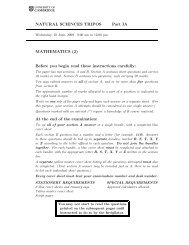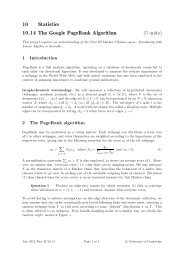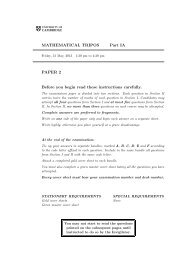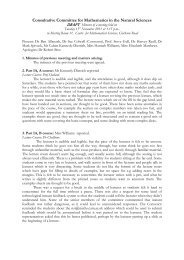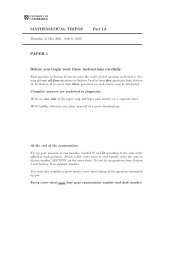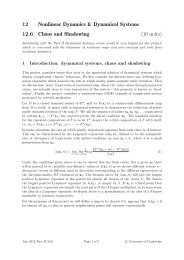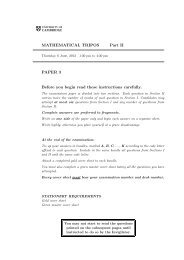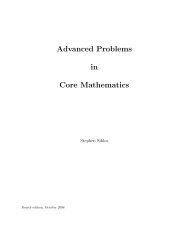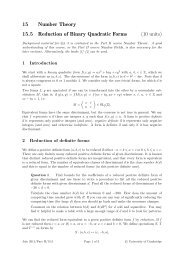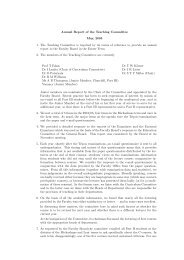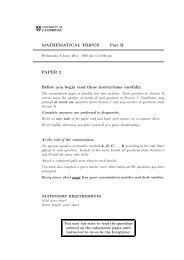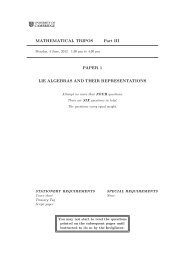MATHEMATICAL TRIPOS Part II PAPER 4 Before you begin read ...
MATHEMATICAL TRIPOS Part II PAPER 4 Before you begin read ...
MATHEMATICAL TRIPOS Part II PAPER 4 Before you begin read ...
- No tags were found...
Create successful ePaper yourself
Turn your PDF publications into a flip-book with our unique Google optimized e-Paper software.
21<br />
38D Waves<br />
The shallow-water equations<br />
∂h<br />
∂t + u∂h ∂x + h∂u ∂x = 0,<br />
∂u<br />
∂t + u∂u ∂x + g ∂h<br />
∂x = 0<br />
describe one-dimensional flow in a channel with depth h(x, t) and velocity u(x, t), where<br />
g is the acceleration due to gravity.<br />
(i) Find the speed c(h) of linearized waves on fluid at rest and of uniform depth.<br />
(ii) Show that the Riemann invariants u ± 2c are constant on characteristic curves<br />
C ± of slope u ± c in the (x, t)-plane.<br />
(iii) Use the shallow-water equations to derive the equation of momentum conservation<br />
∂(hu)<br />
+ ∂I<br />
∂t ∂x = 0 ,<br />
and identify the horizontal momentum flux I.<br />
(iv) A hydraulic jump propagates at constant speed along a straight constant-width<br />
channel. Ahead of the jump the fluid is at rest with uniform depth h 0 . Behind the jump<br />
the fluid has uniform depth h 1 = h 0 (1 + β), with β > 0. Determine both the speed V of<br />
the jump and the fluid velocity u 1 behind the jump.<br />
Express V/c(h 0 ) and (V − u 1 )/c(h 1 ) as functions of β. Hence sketch the pattern of<br />
characteristics in the frame of reference of the jump.<br />
39D Numerical Analysis<br />
(i) Formulate the conjugate gradient method for the solution of a system Ax = b with<br />
A ∈ R n×n and b ∈ R n , n > 0.<br />
(ii) Prove that if the conjugate gradient method is applied in exact arithmetic then, for<br />
any x (0) ∈ R n , termination occurs after at most n iterations.<br />
(iii) The polynomial p(x) = x m + ∑ m−1<br />
i=0 c ix i is the minimal polynomial of the n × n<br />
matrix A if it is the polynomial of lowest degree that satisfies p(A) = 0. [Note<br />
that m n.] Give an example of a 3 × 3 symmetric positive definite matrix with a<br />
quadratic minimal polynomial.<br />
Prove that (in exact arithmetic) the conjugate gradient method requires at most m<br />
iterations to calculate the exact solution of Ax = b, where m is the degree of the<br />
minimal polynomial of A.<br />
END OF <strong>PAPER</strong><br />
<strong>Part</strong> <strong>II</strong>, Paper 4



